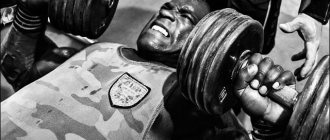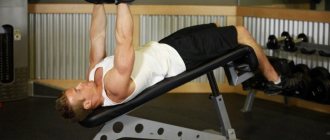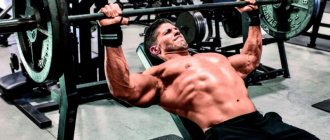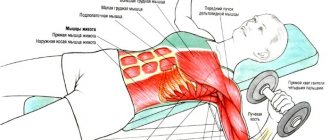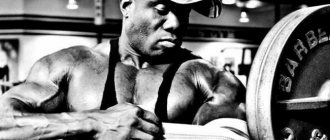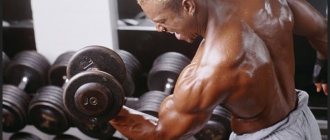Working muscles during dumbbell bench press
The press is a horizontal pressing exercise. This means that your arms press the weight away from your chest, perpendicular to your body. Main muscles involved in this exercise:
- Large pectoral: Most athletes do the bench press solely to pump up the chest with dumbbells, so the load when performed correctly is very high. The main function of the pectoralis is horizontal flexion and medial rotation of the shoulder joint.
- Anterior deltoid: These work in conjunction with the pectoral muscles and are also involved in horizontal flexion and medial rotation of the shoulder joint. It's almost impossible to work on your chest without these muscles.
- Triceps brachii : The triceps, located on the back of the upper arm, is responsible for extending the elbow. The closer your hands are to each other, the more work the triceps have to do. The triceps are especially active at the end of the movement when you straighten your elbows.
- Shoulder girdle muscles: This group of small muscles, consisting of the infraspinatus, teres minor and subscapularis muscles, are responsible for stabilizing the shoulder. They are especially active during exercise because the weight can shift in different directions.
Correct technique for performing the exercise
To get the most out of any exercise, you need to do it correctly. Inaccurate technique reduces performance and increases the risk of injury. Let's take a step-by-step look at how to do the dumbbell bench press correctly:
- Sit at the end of a bench, holding a weight in both hands. Place the weight of the dumbbells on your thighs.
- Lie back and use your legs to lift the weight. Position yourself so that your back is flat on the bench, your arms are bent, and your weight is above your shoulders. Place your feet directly on the floor. Tighten your abs and slightly arch your lower back, pushing your chest forward.
- Raise the dumbbells up to arm length above your chest. Bring the dumbbells together at the top of the movement. Straighten your arms, but do not fully extend your elbows. Otherwise, the load will not be on the muscles, but on the joints.
- Bend your arms and lower them back down. Lower them as much as your flexibility allows. The lower you go, the more difficult and effective the exercise becomes. From the bottom of the movement, try not to make sudden movements to avoid injury.
- For your final set, either lower the dumbbells to the floor or, with your arms bent, simply sit down and return to the starting position. You can ask a friend nearby.
Video: how to independently and safely lift large weights of dumbbells for bench press
Choose the right training program
You shouldn’t grab old dumbbells and squeeze all the juice out of yourself right away. First you need to decide on the purpose of the workout, then the weight and number of repetitions. Use the following guidelines to help you find the right rep range and dumbbell weight:
- For Strength : 3-5 reps, pushing 85%+ of your one-rep max. Rest 3-5 minutes between sets.
- For hypertrophy (muscle growth): 6-12 reps, aiming for 67-85% of your one-rep max. Rest 60-90 seconds between sets.
- For muscle endurance : 13-20+ reps, working at less than 67% of your one-rep max. Rest 30-60 seconds between sets.
We recommend a home workout program for men to pump up muscles without going to the gym.
Not sure what your one-repetition maximum is? It's simple, the weight you choose should fatigue your muscles in a given number of repetitions. If you can't complete the required number of repetitions, then the weight is too heavy, but if you can do more than the specified number, then the weight is too light.
Single dumbbell bench press
In fitness, the one-arm bench press is almost never used. This option requires additional activation of stabilizer muscles in order to maintain the position of the arm with the weight. The technique is commonly used by bench lifters. This option potentially increases strength performance.
Technique:
- Take the projectile in your hands and lie down on the bench. With your other hand, firmly hold the bottom of the bench to stabilize your body.
- Begin to slowly lower your hand until the pancake lightly touches your chest.
- Without pausing, press the weight back to the starting position without straightening your elbow.
The downside is increased trauma , so this exercise should be done with extreme caution.
Unlike other versions, when working with one hand, the lowering and raising of the projectile occurs slowly and under control, without jerking or inertia. Therefore, it is important to carefully select the weight of the burden .
Advantages and Benefits of Dumbbell Bench Press
There are enough facts, relying on which, we can confidently say that presses can be safely classified as a very effective exercise for gaining mass. Here are a few main ones:
They help develop the muscles of both arms, eliminating any imbalances : the exercise helps to develop strength and endurance in both arms at once, without overloading one of them. For all people, one hand is always the dominant one, which can affect the technique and the process of forming muscle mass in the working muscles. This is not a problem until you notice differences in the size of your muscles or get injured. Using dumbbells instead of a barbell will eliminate this problem.
Less stress on the shoulders : The barbell press puts a lot of stress on the shoulder muscles. This is because the bar locks your arms in one position and you cannot rotate your wrists naturally. Dumbbells allow you to rotate your wrists, which takes pressure off your shoulders. Each arm can move freely through its range of motion, which also helps relieve stress on the shoulder joint.
Safe when training alone : each repetition performed with a barbell can be the last in terms of strength and endurance of the working muscles. At this moment, you can find yourself in a very dangerous situation, especially if no one is nearby. There are no such problems with dumbbells; you can simply throw them to the sides.
You can change the range of motion : you can do incline and regular presses with a barbell, but this requires a special bench, and not all gyms have one. To perform bench presses with dumbbells, a regular bench with varying inclination angle is suitable. A bench raised up will put more stress on the upper chest, and a bench lowered will put more stress on the lower chest. The flat surface allows you to evenly work on all parts of the chest.
Joint stability : during the exercise, you need to learn to control the weight - manage it. This results in greater activation of the shoulder girdle muscles and stabilization of the shoulder joints, which significantly reduces the risk of injury2.
Benefits[edit | edit code]
Dumbbell bench press (video)
The dumbbell press has some amazing benefits. Firstly, few people now do dumbbell presses, but barbell presses, on the contrary, are very popular. This “unpopularity” of dumbbell presses can work to your advantage. As long as you have the right dumbbells, you can do dumbbell presses in a modern, crowded gym where you often have to wait in a long line to do a barbell bench press. Second, the dumbbell bench press does not require a power rack or other safety devices. Additionally, having an assistant is not mandatory (although highly recommended). Thirdly, often people who, for some reason related to their physique, cannot perform barbell bench presses, can nevertheless do dumbbell presses.
Bench Press Variations
If you do the same movement for a long time, the muscles get used to it and efficiency decreases. Vary your workouts with different variations of this exercise.
Bench Press with Dumbbell Reduction
This variation with a narrow grip, or as it is also called neutral, does a good job of loading the inner part of the pectoral muscle. It is very effective for building muscle mass in this area. The grip is a little different from the usual parallel grip. Here you will press dumbbells simultaneously and together, the total weight of the load can be slightly reduced.
How to do it:
- Hold dumbbells in both hands and set up as if you were doing a regular bench press. Press the dumbbells together throughout the exercise, feeling the tension in your arms.
- Raise the dumbbells until your arms are fully extended, and then lower them back to your chest. Keep bringing them together!
This variation can be performed either lying on a flat surface or on a bench with an adjustable incline.
One-arm dumbbell press
In this variation, you use only one dumbbell and work each arm separately. An excellent variation for pumping each chest separately and core stabilizer muscles. Among other things, you will have to strain very hard to maintain balance and the correct position.
How to do:
- Grab one dumbbell and get ready for a regular push-up. Place your feet firmly on the floor and tighten your abdominal muscles.
- Without changing the position of your shoulders and hips, lift the weight until your arm is fully extended, and then lower it again.
- Make the same amount on each side.
This variation can be performed either lying on a flat surface or on a bench with a different inclination.
Floor press
No bench?
No problem! Dumbbell presses can be done on the floor. This option is suitable for those for whom lowering the weight to the chest causes shoulder pain. How to do it:
- Lie on the floor with your knees bent and your feet flat on the floor. Raise the dumbbells above your chest.
- Bend your arms and lower them down to the floor. Repeat.
This exercise can also be performed with one dumbbell or with curled dumbbells.
Dumbbell press with alternating hands
This exercise not only allows you to work one arm at a time, but also improves coordination and core strength. This is a good exercise for muscular endurance and works well when used as part of a fat-burning workout.
How to do it:
- Take the starting position as with a regular variation. Hold one dumbbell close to your chest and lift the other up.
- Then raise your second hand while lowering the first.
- Continue alternating sides throughout the entire set.
The angle of the bench can be changed when performing this version of the press.
Dumbbell press on fitball
How to do it:
- Start sitting on a stability ball with dumbbells in both palms. Focusing on your feet, lean back until your entire back, shoulders and head are on the ball. Tighten your legs and core.
- Start the movement with your arms bent at right angles up until they are straightened, then lower them. Make sure to keep your hips and shoulders still and level.
On a fitball you can perform the variations described above.
Dumbbell bench press technique
This is one of the few exercises in which you should take into account not only the execution of all elements of the movement, but also the removal of the projectile to the starting position.
Technique for performing dumbbell bench press:
- Sit on the edge of the bench. Place weights on your hips. Lean back while lifting your hips to push (to bring the implements into position).
- In the starting position, the back and back of the head should be pressed tightly to the surface. The weight is held on extended arms (with slightly bent elbows) so that the forearms are perpendicular to the floor.
- Start lowering the weights downwards at a moderate pace until they lightly touch your chest.
- With a powerful movement, push the weight back to the starting position without straightening your elbows completely.
It is important that lowering the weight be done a little slower than lifting it. It is also necessary to ensure that the back of the head is pressed tightly against the back throughout the entire exercise. After finishing the set, lower the weight to your chest, push up with your back and assume a sitting position.
Advantages of dumbbell flyes over barbell presses
The second option, i.e. The barbell press, extremely popular among athletes, loads the entire muscle layer of the pectoral muscles, but most of all the middle and lower sections. But, despite such popularity, this chest training exercise is not the best in terms of developing muscle texture, although it is ideal for increasing strength.
To maximize the involvement of fibers in the work, lying dumbbell flyes are more productive. The training better isolates the chest (the only joint works) and thoroughly works the upper section, therefore effectively developing the width and creating symmetry of the pectoral muscles.
Conclusion: if the goal is strong muscles, then choose a barbell. If - stretching and development of width - then wiring. It’s even better to combine both exercises to build harmonious chest muscles.
Video: Dumbbell flyes lying on a bench
Execution technique
In this type of bench press, technique plays a very important role. Since the reverse grip is considered not the most reliable and there is a risk of the bar falling. To prevent this from happening, you need to position the bar correctly. It should lie slightly diagonally, closer to the base of the palm. Such a grip will not allow the wrist to bend strongly in the opposite direction.
Initial position:
- The exercise is performed on a regular bench press.
- It is very important to choose the right bar height. It needs to be placed a little lower than with a classic bench press. That is, when removing the barbell, your arms should be bent at the elbow joints.
- We lie down on the bench. We bring the shoulder blades together and lower them down. The pelvis is pressed against the bench. There is a slight arch in the lower back. There is no need to do a bridge, unless of course you plan to press the barbell in a powerlifting style.
- Legs are spread apart. Feet should be completely flat on the floor. No need to put them on the toe. This can affect your resilience.
- The bar is at eye level. We grab it with a reverse grip. Let's not forget what we talked about earlier. The bar lies closer to the base of the palms. 4 fingers wrap around the bar on one side, and the thumb on the other. Hands are positioned slightly wider than shoulders.
- Exhale and remove the bar from the racks. We bring it forward until the bar is at the level of the middle of the pectoral muscles.
Performance:
- From the starting position, while inhaling, we begin to lower the barbell to the lower part of the pectoral muscles. In this exercise, the trajectory of the barbell is set itself, so you don’t have to worry about it. The main thing is to feel the stretch in the pectoral muscles.
- After the bar touches the bottom of the pecs, together with the exhalation we squeeze the barbell to the starting position.
There is one popular exercise that is mechanically similar to the reverse grip press. We are talking about CLOSING THE HANDS IN A CROSSOVER FROM THE LOWER BLOCK. If you have performed it before, then mastering the reverse press technique will be much easier for you.
Technique, recommendations, features
The reverse grip dumbbell press is performed while lying on a bench. It is better to place the element after a basic strength exercise (for example, push-ups). Technique:
- Take two dumbbells with a reverse grip and lie on your back on a horizontal bench.
- Slightly arch your lumbar spine and tighten your abdominal muscles.
- The initial position of the projectiles is on the sides, on the line of the solar plexus.
- Exhale and press the dumbbells up.
- Hold for 1-2 seconds, then inhale and lower the weight.
Recommendations:
- The palm grip should be closed. Otherwise, you risk dropping the projectile on your head or chest.
- At the top point, do not bring the dumbbells together with their ends. This implementation reduces the payload.
- If it is difficult to keep your clenched hands in one line, you can slightly turn them inward.
- Push the weight directly above your chest. When you move the dumbbells “towards your eyes”, the triceps will receive the load.
- Control both phases of movement. Avoid projectile tossing and rapid descents.
- Select the weight so that you can do 3-4 sets of 12-15 full repetitions at a slow pace.
- Try not to spread your elbows wide. Otherwise, the back muscles will be involved in the work.
Reverse presses can also be performed with a straight bar, but the load should be selected correctly. You should not focus on the weight of the apparatus in the classic bench press, as it will be much higher due to the inclusion of all three sections of the chest, as well as the back muscles.
We recommend starting with a barbell that weighs 20-25% of your classic chest press maximum.
In addition, remember that removing and placing the bar on the plinths is dangerous without external assistance. Therefore, be sure to use your partner’s insurance!
